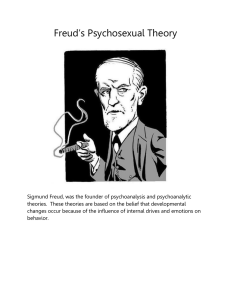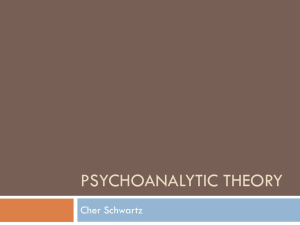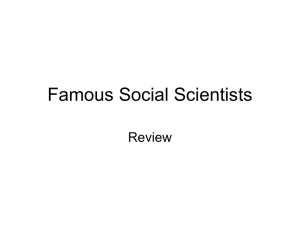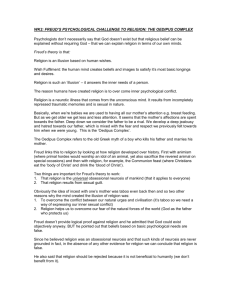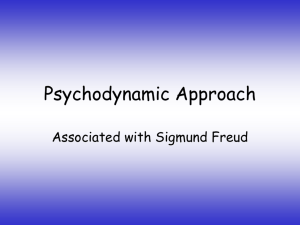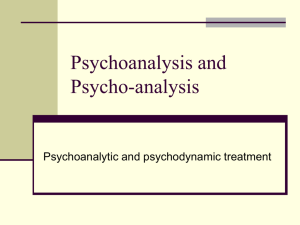Chapter 2 Freud`s Psychoanalytic Theory
advertisement
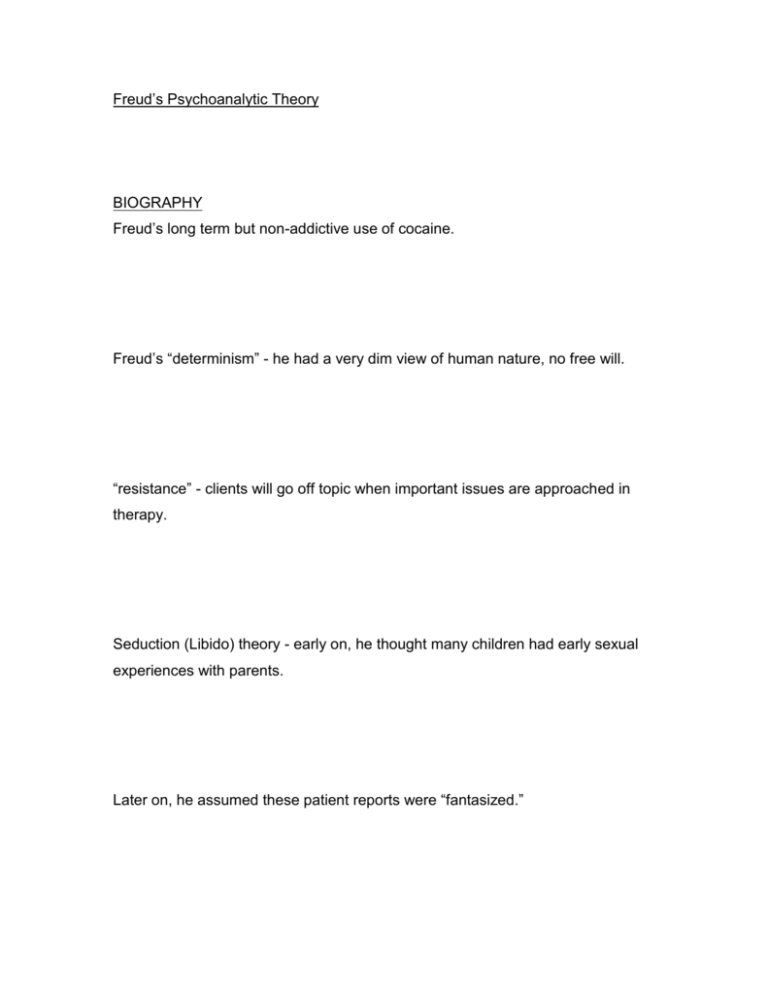
Freud’s Psychoanalytic Theory BIOGRAPHY Freud’s long term but non-addictive use of cocaine. Freud’s “determinism” - he had a very dim view of human nature, no free will. “resistance” - clients will go off topic when important issues are approached in therapy. Seduction (Libido) theory - early on, he thought many children had early sexual experiences with parents. Later on, he assumed these patient reports were “fantasized.” neopsychoanalytic perspective - theories of those who followed Freud (e.g., Jung). Freud’s cigar habit and cancer. Freud’s fainting spells and phobias. CONCEPTS AND PRINCIPLES three levels of consciousness (aspects of mental life) 1. conscious - things we are currently aware of. 2. preconscious - we are not currently aware of this but can be with a little effort. 3. unconscious - we will rarely if ever know what is in out unconscious. Instincts are needs that reside in the unconscious, they are generated by the ID. They have and four characteristics: 1. source - bodily deficit or need (like food deprivation). 2. aim - what will gratify the need (to eat). 3. impetus - what propels us to act (like hunger). 4. object - through which the instinct achieves its aim (like food). life instincts (eros) esp. libido - instincts directed at survival of the self and species. death instincts (thanatos) - instincts directed towards death (the only way to be free of conflict). three divisions of personality 1. id - primitive source of sexual and aggressive urges, operates on the “pleasure principal” (maximizing pleasure at any cost) 2. ego - rational part of the personality that tries to satisfy the id within the boundaries set by the superego. It operates on the “reality principle.” 3. superego - internalized values of family and society. [conscience develops (via guilt) and ego ideal (via reward)]. id-superego conflict - results in danger to the ego and anxiety. defense mechanisms - unconscious processes for coping with anxiety. 1. repression - keeping unpleasant thoughts unconscious. 2. sublimation - channeling negative feelings into a positive outlet. 3. undoing - trying to compensate for a harmful act by doing its opposite. 4. compromise formation - using contradictory behaviors to get some gratification for a negative impulse…. ….(e.g., great job, I never would have believed you could do it!) repression - is “the fundamental defense mechanism.” PERSONALITY DEVELOPMENT five “psychosexual stages” of development: at each stage “libido” energy focuses on a different body part. 1. oral - focus is on the mouth, eating, sucking, chewing. 2. anal – focus is on the anus and defecation, toilet training is an issue. 3. phallic – focus is on the genitals, Oedipus and Electra complexes emerge. 4. latency – sexual interest goes underground, Oedipus and Electra complexes are resolved by child identifying with the same sex parent. 5. genital – if the rest of the stages were navigated successfully, normal sexual adjustment is achieved. Oedipus and Electra complexes - emerge during the phallic stage and are “resolved” during the latency stage. fixation - too much or too little “gratification” at a stage can halt one’s development at that stage. character types - reflect fixation or healthy development: 1. oral receptive character - results from overindulgence during the oral stage. Dependence is the result. 2. oral aggressive - results from underindulgence during the oral stage. Envy, dominance, and manipulation of others is the result. 3. anal - results from difficulty in toilet training. Stinginess, frugality, rigidity, and perfectionism are the result. 4. phallic - stems from inadequate resolution of the Oedipus or Electra complex. Result is the “Don Juan” type in males and for females being domineering and castrating. 5. genital - the stages have been successfully navigated, the person is sexually healthy. Study by Tribich and Messer (1974), used the “autokinetic effect” in an experiment to collect support for the oral character. Students identified as “high orals” via the “Blacky Pictures” were more influenced by an authority figure’s opinion. Evidence for parenting practices as the source of the character types is WEAK. ASSESSMENT TECHNIQUES free association - the person simply talks about whatever comes to mind. parapraxis - a slip of the tongue (e.g., a non-believer calling him Sigmund Fraud). dream analysis - we act out our desires and wishes in dreams in disguised form. manifest content - what the dream looks like (e.g., I’m a knight killing the king). latent content - what the dream means (e.g., I want to kill my father). transference - the patient acting towards the therapist as if he/she were an important person in the patient’s life. 1. positive - acting as if the therapist is a loved parent. 2. negative - acting as if the therapist is a hated authority figure. 3. counter transference - therapist acting as if the patient is someone in his life. THEORY’S IMPLICATIONS FOR THERAPY neurosis - ineffective coping with everyday problems. psychosis - a serious inability to communicate with others. psychoanalysis - through various techniques, the patient gains awareness and “insight” into traumas, needs, desires, etc. that he or she was unaware of. case of the “rat man” - famous case study of a man with “obsessive compulsive disorder.”


